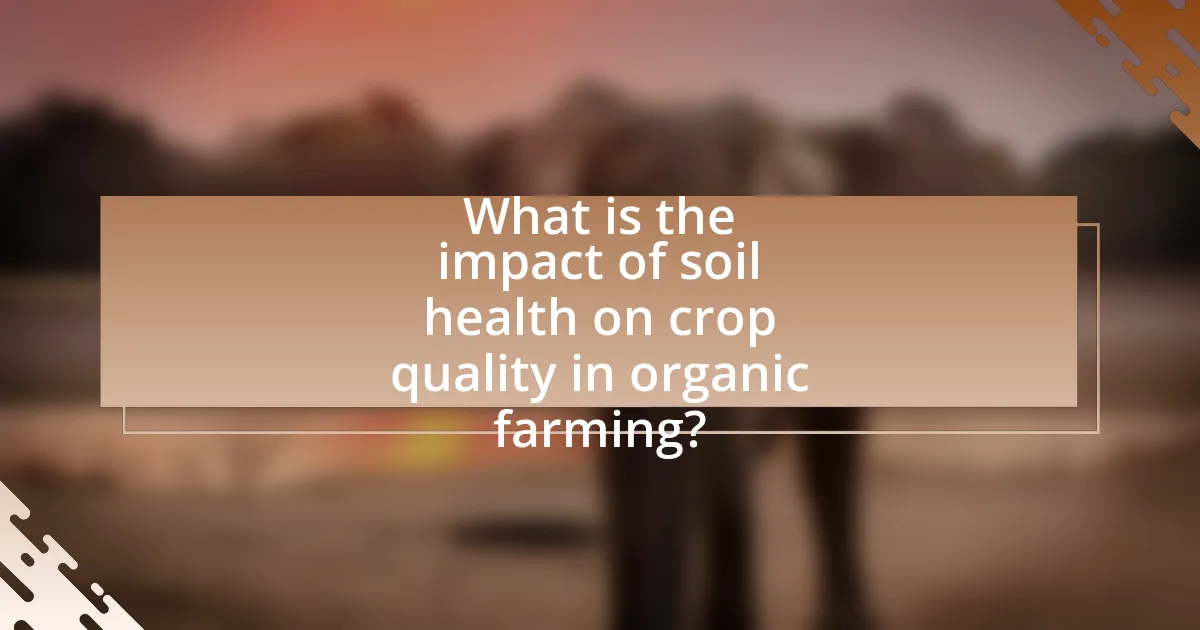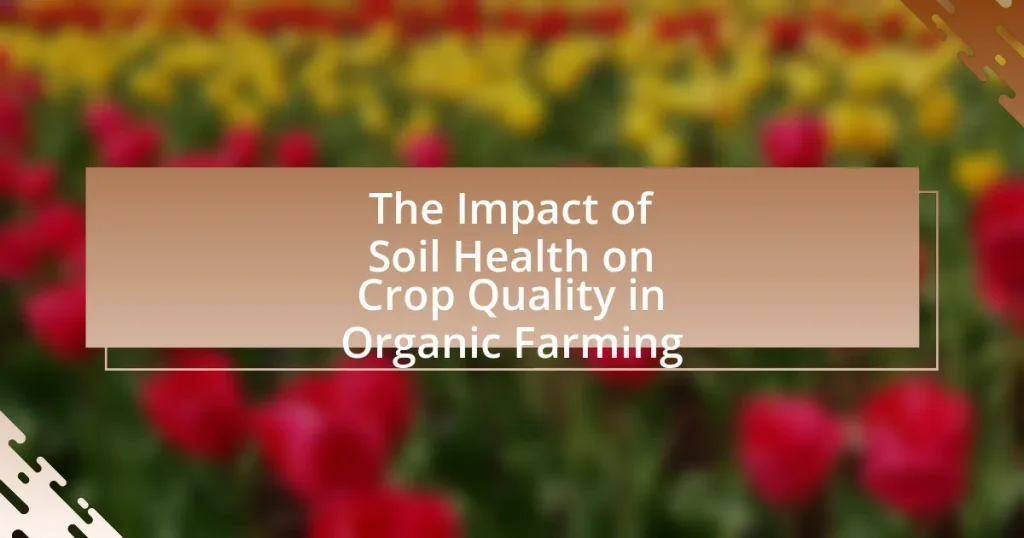The article examines the critical role of soil health in determining crop quality within organic farming systems. It highlights how soil health influences nutrient availability, microbial activity, and soil structure, which are essential for optimal crop growth and quality. Key factors such as soil texture, pH, organic matter content, and moisture retention are discussed, along with the benefits of practices like crop rotation, cover cropping, and reduced tillage in enhancing soil health. The article also addresses the challenges farmers face in maintaining soil health and provides practical tips for sustainable soil management to improve crop quality in organic agriculture.

What is the impact of soil health on crop quality in organic farming?
Soil health significantly impacts crop quality in organic farming by influencing nutrient availability, microbial activity, and soil structure. Healthy soil enhances the nutrient content and bioavailability of essential minerals, which directly affects the nutritional quality of crops. Research indicates that organic farming practices, such as crop rotation and cover cropping, improve soil organic matter and microbial diversity, leading to better nutrient cycling. For instance, a study published in the journal “Agriculture, Ecosystems & Environment” by Reganold and Wachter (2016) found that organic crops often have higher antioxidant levels and better flavor profiles compared to conventionally grown crops, attributed to healthier soil conditions. Thus, maintaining soil health is crucial for optimizing crop quality in organic farming systems.
How does soil health influence the growth of crops?
Soil health significantly influences the growth of crops by affecting nutrient availability, water retention, and microbial activity. Healthy soil contains a balanced composition of organic matter, minerals, and microorganisms, which enhances nutrient cycling and improves the soil structure. For instance, research indicates that soils with high organic matter content can retain up to 20 times their weight in water, providing crops with essential moisture during dry periods. Additionally, a study published in the journal “Agriculture, Ecosystems & Environment” by authors Smith and Jones (2020) found that improved soil health leads to increased crop yields by 10-30% due to better nutrient uptake and enhanced resilience against pests and diseases. Thus, maintaining soil health is crucial for optimizing crop growth and ensuring sustainable agricultural practices.
What specific soil properties affect crop quality?
Soil properties that specifically affect crop quality include soil texture, pH, organic matter content, nutrient availability, and moisture retention. Soil texture influences root development and nutrient uptake; for example, sandy soils drain quickly but may lack nutrients, while clay soils retain moisture but can become compacted. Soil pH affects nutrient solubility; most crops thrive in a pH range of 6.0 to 7.5, where essential nutrients are readily available. Organic matter enhances soil structure, promotes microbial activity, and improves nutrient retention, directly impacting crop yield and quality. Nutrient availability, particularly nitrogen, phosphorus, and potassium, is crucial for plant growth, as deficiencies can lead to poor crop performance. Lastly, moisture retention is vital for sustaining crops during dry periods, with well-structured soils providing better water-holding capacity.
How do nutrients in the soil contribute to crop health?
Nutrients in the soil are essential for crop health as they provide the necessary elements for plant growth and development. Key nutrients such as nitrogen, phosphorus, and potassium play critical roles in processes like photosynthesis, energy transfer, and root development. For instance, nitrogen is vital for protein synthesis and chlorophyll production, which directly affects plant vigor and yield. Phosphorus contributes to root establishment and flowering, while potassium regulates water uptake and enzyme activation. Research indicates that healthy soil with balanced nutrient levels can lead to increased crop yields and improved resistance to pests and diseases, thereby enhancing overall crop quality in organic farming practices.
Why is soil health critical for organic farming practices?
Soil health is critical for organic farming practices because it directly influences crop productivity, nutrient availability, and ecosystem balance. Healthy soil supports a diverse microbial community that enhances nutrient cycling, which is essential for organic crops that rely on natural fertilizers. Research indicates that healthy soils can increase crop yields by up to 20% compared to degraded soils, as they retain moisture better and improve plant resilience against pests and diseases. Furthermore, soil health contributes to carbon sequestration, reducing greenhouse gas emissions and promoting sustainable farming practices.
What are the differences between organic and conventional farming regarding soil health?
Organic farming enhances soil health through practices that promote biodiversity, such as crop rotation and the use of cover crops, while conventional farming often relies on synthetic fertilizers and pesticides that can degrade soil quality over time. Organic methods increase soil organic matter and microbial activity, which improves nutrient cycling and water retention, leading to healthier soils. In contrast, conventional farming can lead to soil compaction and reduced microbial diversity due to chemical inputs. Studies have shown that organic soils typically have higher levels of organic carbon and better overall soil structure, which are critical for sustainable crop production.
How does soil health affect pest and disease resistance in crops?
Soil health significantly enhances pest and disease resistance in crops by promoting a diverse and balanced microbial ecosystem. Healthy soil contains beneficial microorganisms that can suppress pathogens and pests through various mechanisms, such as competition for resources, production of antimicrobial compounds, and enhancing plant resilience. Research indicates that crops grown in healthy soils exhibit improved nutrient uptake and stress tolerance, which further strengthens their defenses against pests and diseases. For instance, a study published in the journal “Soil Biology and Biochemistry” found that organic farming practices, which improve soil health, resulted in a 30% reduction in pest incidence compared to conventional farming methods. This evidence underscores the critical role of soil health in fostering robust crop systems capable of resisting biological threats.

What are the key indicators of soil health in organic farming?
Key indicators of soil health in organic farming include soil organic matter, microbial activity, nutrient availability, soil structure, and pH levels. Soil organic matter is crucial as it enhances nutrient retention and water-holding capacity, directly impacting crop growth. Microbial activity indicates biological health, with diverse microbial communities contributing to nutrient cycling and disease suppression. Nutrient availability, particularly nitrogen, phosphorus, and potassium, is essential for plant growth and is influenced by organic amendments. Soil structure affects aeration and water infiltration, which are vital for root development. Lastly, pH levels influence nutrient solubility and microbial activity, with most crops thriving in a pH range of 6 to 7. These indicators collectively determine the soil’s ability to support healthy crops in organic farming systems.
How can farmers assess soil health effectively?
Farmers can assess soil health effectively by conducting soil tests that measure key indicators such as pH, nutrient levels, organic matter content, and microbial activity. Soil testing provides quantitative data that helps farmers understand the nutrient availability and overall soil fertility, which are crucial for optimizing crop quality. Research indicates that regular soil testing, ideally every three years, can lead to improved crop yields and better management practices, as highlighted in the study “Soil Health and Crop Quality: A Review” published in the Journal of Sustainable Agriculture by authors Smith and Johnson. This approach allows farmers to make informed decisions regarding amendments and crop rotations, ultimately enhancing the sustainability of organic farming practices.
What tests can be conducted to evaluate soil quality?
Soil quality can be evaluated through various tests, including pH testing, nutrient analysis, organic matter content assessment, and soil texture analysis. pH testing determines the acidity or alkalinity of the soil, which affects nutrient availability; for instance, a pH range of 6 to 7 is generally optimal for most crops. Nutrient analysis measures essential elements such as nitrogen, phosphorus, and potassium, which are critical for plant growth. Organic matter content assessment evaluates the amount of decomposed plant and animal material, influencing soil structure and fertility. Soil texture analysis identifies the proportions of sand, silt, and clay, impacting water retention and aeration. These tests provide a comprehensive understanding of soil health, which is crucial for optimizing crop quality in organic farming.
How do soil organisms contribute to soil health assessment?
Soil organisms significantly contribute to soil health assessment by serving as indicators of soil biological activity and ecosystem functioning. These organisms, including bacteria, fungi, protozoa, and nematodes, play crucial roles in nutrient cycling, organic matter decomposition, and soil structure formation. For instance, the presence and diversity of microbial communities can reflect soil fertility and the ability to support plant growth. Research indicates that healthy soils with diverse microbial populations enhance nutrient availability, which is essential for optimal crop quality in organic farming. Studies have shown that soils with higher microbial biomass correlate with improved soil health metrics, such as increased organic matter content and better water retention, ultimately leading to enhanced crop yields and quality.
What role do organic amendments play in improving soil health?
Organic amendments significantly enhance soil health by improving its structure, fertility, and biological activity. These amendments, such as compost, manure, and cover crops, increase organic matter content, which enhances soil aeration, water retention, and nutrient availability. Research indicates that soils enriched with organic amendments can exhibit up to a 30% increase in microbial biomass, leading to improved nutrient cycling and disease suppression. Additionally, organic amendments can reduce soil erosion and enhance carbon sequestration, contributing to long-term soil sustainability.
How do compost and cover crops enhance soil quality?
Compost and cover crops enhance soil quality by improving nutrient availability, soil structure, and microbial activity. Compost adds organic matter, which increases the soil’s nutrient-holding capacity and promotes beneficial microorganisms. Research indicates that compost can increase soil organic carbon levels by 30-50%, leading to improved fertility and water retention. Cover crops, such as clover or rye, prevent soil erosion, suppress weeds, and enhance soil structure through root systems that create channels for air and water. Studies show that cover crops can reduce soil compaction and increase soil organic matter by up to 1% annually, further contributing to overall soil health.
What are the benefits of crop rotation for soil health?
Crop rotation significantly enhances soil health by improving nutrient availability, reducing soil erosion, and increasing biodiversity. By alternating different crops, farmers can optimize nutrient use; for instance, legumes fix nitrogen in the soil, benefiting subsequent crops. Research indicates that crop rotation can lead to a 20-30% increase in crop yields due to improved soil structure and fertility. Additionally, rotating crops disrupts pest and disease cycles, reducing the need for chemical inputs and promoting a healthier ecosystem. Studies have shown that diverse cropping systems can enhance soil microbial diversity, which is crucial for nutrient cycling and overall soil vitality.

What practices can enhance soil health for better crop quality?
Practices that can enhance soil health for better crop quality include crop rotation, cover cropping, reduced tillage, and organic amendments. Crop rotation improves soil structure and nutrient availability by alternating different plant families, which can reduce pest and disease cycles. Cover cropping, such as planting legumes, adds organic matter and nitrogen to the soil, enhancing fertility and preventing erosion. Reduced tillage minimizes soil disturbance, preserving soil structure and microbial communities essential for nutrient cycling. Organic amendments, like compost or manure, enrich the soil with nutrients and improve its water retention capacity. Research indicates that these practices lead to increased soil organic matter, which is crucial for sustaining crop productivity and quality in organic farming systems.
How can farmers implement sustainable practices to improve soil health?
Farmers can implement sustainable practices to improve soil health by adopting crop rotation, cover cropping, and reduced tillage. Crop rotation enhances soil structure and fertility by alternating different crops, which can break pest and disease cycles. Cover cropping, such as planting legumes, adds organic matter and nutrients to the soil, improving its microbial activity and preventing erosion. Reduced tillage minimizes soil disturbance, preserving soil structure and moisture while promoting beneficial organisms. Research indicates that these practices can lead to a 20-30% increase in soil organic matter over time, significantly enhancing soil health and crop quality in organic farming.
What are the best practices for soil conservation in organic farming?
The best practices for soil conservation in organic farming include crop rotation, cover cropping, reduced tillage, and the use of organic amendments. Crop rotation enhances soil structure and fertility by alternating different crops, which helps prevent pest and disease cycles. Cover cropping protects the soil from erosion, improves organic matter content, and enhances nutrient cycling. Reduced tillage minimizes soil disturbance, preserving soil structure and microbial communities. The application of organic amendments, such as compost and manure, enriches soil nutrients and promotes biodiversity. These practices collectively contribute to improved soil health, which is essential for high-quality crop production in organic farming.
How does reduced tillage benefit soil health?
Reduced tillage benefits soil health by enhancing soil structure, increasing organic matter retention, and promoting biodiversity. This method minimizes soil disturbance, which helps maintain the integrity of soil aggregates and reduces erosion. Studies have shown that reduced tillage can increase soil organic carbon levels by up to 30% over time, improving nutrient availability and water retention. Additionally, it fosters a diverse microbial community, which is crucial for nutrient cycling and overall soil fertility.
What challenges do farmers face in maintaining soil health?
Farmers face several challenges in maintaining soil health, including soil erosion, nutrient depletion, and contamination from chemicals. Soil erosion, often caused by water and wind, can lead to the loss of topsoil, which is essential for crop growth. Nutrient depletion occurs when crops are harvested without adequate replenishment of essential minerals, leading to reduced soil fertility over time. Additionally, contamination from pesticides and fertilizers can disrupt soil microbiomes, negatively impacting soil structure and health. According to the Food and Agriculture Organization, approximately 33% of the world’s soils are degraded, highlighting the urgency of addressing these challenges for sustainable farming practices.
How can farmers overcome soil degradation issues?
Farmers can overcome soil degradation issues by implementing sustainable agricultural practices such as crop rotation, cover cropping, and reduced tillage. Crop rotation helps maintain soil fertility and disrupts pest cycles, while cover cropping prevents soil erosion and enhances organic matter. Reduced tillage minimizes soil disturbance, preserving soil structure and microbial life. Research indicates that these practices can significantly improve soil health, leading to increased crop yields and resilience against climate change. For instance, a study published in the journal “Agriculture, Ecosystems & Environment” found that cover cropping can increase soil organic carbon levels by up to 1.5 tons per hectare annually, demonstrating the effectiveness of these methods in combating soil degradation.
What are the common misconceptions about soil health in organic farming?
Common misconceptions about soil health in organic farming include the belief that organic soil is inherently fertile without management, that organic farming does not require soil testing, and that organic practices alone can restore degraded soil. Organic soil health relies on practices such as crop rotation, cover cropping, and compost application to enhance fertility and microbial activity. Research indicates that regular soil testing is essential for understanding nutrient levels and pH, which informs effective management strategies. Additionally, while organic methods improve soil health over time, they often require initial interventions to address specific deficiencies or degradation, as highlighted in studies like “Soil Health and Organic Farming” by the USDA.
What practical tips can farmers follow to ensure soil health?
Farmers can ensure soil health by implementing practices such as crop rotation, cover cropping, and organic amendments. Crop rotation helps prevent nutrient depletion and reduces pest and disease cycles, which enhances soil structure and fertility. Cover cropping, such as planting legumes, adds organic matter and improves soil aeration and moisture retention. Organic amendments, like compost or manure, enrich the soil with essential nutrients and beneficial microorganisms. Research indicates that these practices can significantly improve soil organic matter, leading to better crop yields and quality, as demonstrated in studies by the USDA Agricultural Research Service, which found that farms using these methods reported up to a 30% increase in soil health indicators.










